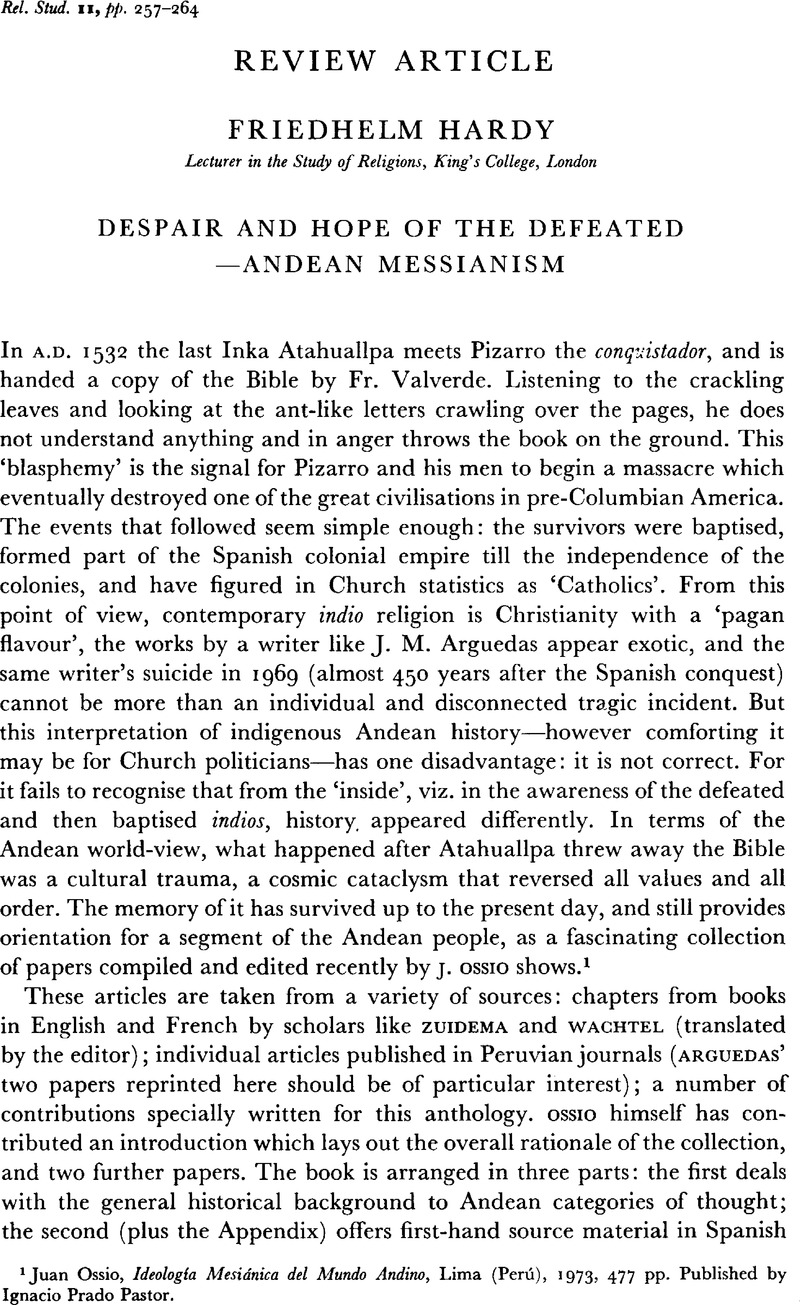Article contents
Despair and Hope of the Defeated—Andean Messianism
Published online by Cambridge University Press: 24 October 2008
Abstract

- Type
- Review Article
- Information
- Copyright
- Copyright © Cambridge University Press 1975
References
page 257 note 1 Ossio, Juan, Ideologla Mesidnica del Mundo Andino, Lima (Peru), 1973, 477 pp. Published by Ignacio Prado Pastor.Google Scholar
page 258 note 1 Pp. 1–214.
page 258 note 2 zuidema: Cabello Valboa, Vázquez de Espinosa, Sarmiento; ossio: Guaman Poma.
page 258 note 3 Wachtel, p. 123.
page 258 note 4 Discussed in two papers by millones, and in the second article by wachtel.
page 258 note 5 Millones, p. 97.
page 258 note 6 Paper by espinoza.
page 258 note 7 They were thus different from the military revivalist movement in México known as the Mixton war of 1541/2; see wachtel, pp. 125–7.
page 259 note 1 Especially pp. 37–49.
page 259 note 2 As a typical example The Tragedy of the Death of Atahuallpa, a kind of drama widely performed in Penú and Bolivia, which may well have its origins in the sixteenth century, has been selected by Wachtel.
page 259 note 3 Wachtel, pp. 121 f.
page 259 note 4 E.g. p. 88.
page 259 note 5 P. 129.
page 259 note 6 In his first paper, pp. 37–70.
page 259 note 7 P. 148.
page 260 note 1 pp. 215–374; 459–77.
page 260 note 2 Q means that the Quechua text is also printed, along with a Spanish translation.
page 260 note 3 Years in brackets refer to the date of publication, when the year of the original recording is not known.
page 260 note 4 n indicates that this material is published here for the first time.
page 260 note 5 One wonders whether across the border in Bolivia similar material could be found.
page 261 note 1 See the map on p. ix.
page 261 note 2 No. 14, p. 351.
page 261 note 3 Already Guaman Poma uses this name for the Spaniards, pp. 166 f. In Bolivian Quechua it isused for addressing a non-indio.
page 261 note 4 No. 13, p. 347.
page 262 note 1 As argued as has pointed out, pp. 386–9.
page 262 note 2 P. 243.
page 263 note 1 P. 243, my italics.
page 263 note 2 P. 248.
page 263 note 3 Pp. 375–458.
page 264 note 1 P. 411, my italics.
page 264 note 2 In the Introduction, pp. xi-xxxv.
page 264 note 3 P. xxii, my italics.
page 264 note 4 Pp. xii f.
page 264 note 5 P. xii.
page 264 note 6 P. xxviii.
page 264 note 7 In this connection, reference must be made to a work by A. Ortiz Rescaniere (one of the contributers to the present anthology), De Adaneva a Inkarrí (Una visión indígena del Perú), Lima, 1973, 190 pp.Google Scholar Published by Retablo de Papel. Here the author attempts to characterise the general conception of the world in Andean thought on the basis of a number of myths (including those of the Inkarri) collected among Quechua-speaking indios in modern Perú.
- 1
- Cited by


